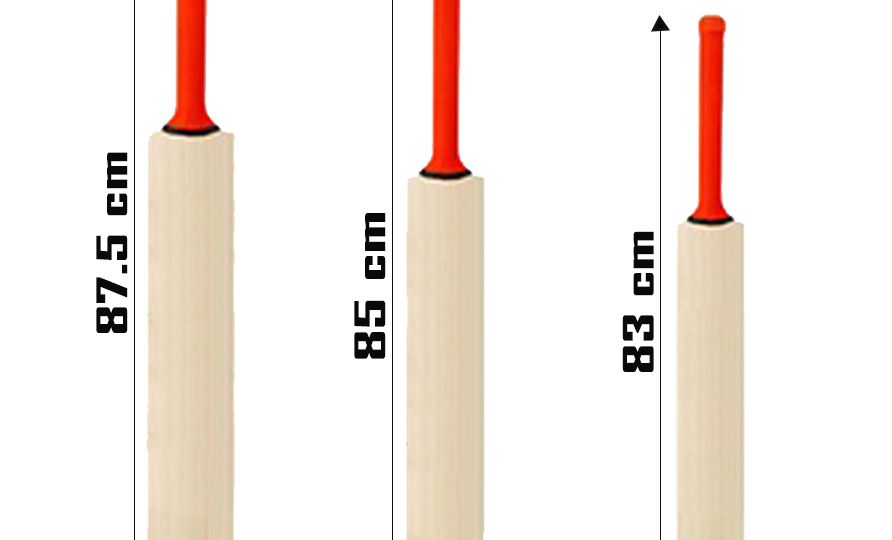- No products in the cart.

Choosing the right cricket bat is essential for any cricketer, whether you are a beginner or a professional. The bat plays a crucial role in determining your performance on the field. With a variety of options available in terms of sizes, brands, and materials, making the right choice can be a daunting task. This guide will walk you through the different factors to consider when selecting the perfect cricket bat for you.
1. Understanding Bat Sizes
The first thing to consider when selecting a cricket bat is the size. Cricket bats come in various sizes, and choosing the right size ensures better control, comfort, and power. The right bat size should match your height and playing style.
Adult Bat Sizes
- Short Handle (SH): This is the most common size for adults and is suitable for players who are above 5’7” in height. A short handle provides a good balance between power and control.
- Long Handle (LH): Ideal for players who are taller than 6 feet, this bat size offers extra reach and better control when playing shots.
- Harrow: This size is for players who are between 5’3” and 5’7” tall. It is slightly smaller than the adult sizes and works well for teenagers or young adults.
- Full Size: Also known as “Full Size” or “Standard Size,” this is the traditional adult bat for players of average height.
Junior Bat Sizes
Junior bats are categorized according to the age of the player:
- Size 0-6: These sizes are for children. The smallest bats are for kids aged between 4 to 8 years, and as they grow, they can graduate to larger sizes.
- Size 6: This is for players who are approximately 9 to 11 years old.
- Size 5: Suitable for children aged 10-12 years.
- Size 4, 3, 2: The sizes are progressively larger, and each suits kids of different age ranges.
When selecting a cricket bat size, ensure that the bat is neither too heavy nor too light. The right size should allow you to comfortably hold the bat and swing it without difficulty. You should be able to grip it easily and perform shots with control.
2. Choosing the Right Bat Material
The material of the cricket bat affects the performance, feel, and durability of the bat. The two main types of material used in cricket bats are willow wood and composite materials.
Willow Wood
Willow is the most commonly used wood for making cricket bats. It is lightweight, durable, and has excellent power retention properties.
- English Willow: This is considered the best material for making cricket bats. English willow is grown in the UK and has a fine grain structure that offers excellent power and control. It’s used by most top professional players. However, English willow bats tend to be more expensive.
- Kashmir Willow: Kashmir willow is another common material used in cricket bats. It is grown in the Kashmir region of India and is a more affordable alternative to English willow. While it is a bit heavier and less powerful than English willow, it is still a reliable option for club and amateur cricketers.
Composite Bats
Composite bats are made from a mixture of materials like carbon fiber and fiberglass. They are lighter and offer more durability than traditional wooden bats. While they are commonly used in the form of lightweight training bats or for younger players, professional cricketers tend to prefer wooden bats because of the better feel and control they provide.
3. Bat Shape and Profile
The shape and profile of a cricket bat significantly influence the power and balance it offers. Different bat shapes cater to different playing styles.
Traditional Profile
The traditional bat profile has a balanced shape with a thick blade and a short spine. It is ideal for players who focus on precise and technical shots. The traditional profile gives more control and helps with timing.
Power Profile
This profile features a higher spine and a larger sweet spot. These bats are designed for players who prefer to hit big shots and generate more power. The thicker blade and larger sweet spot allow for explosive shots, but it may compromise control.
Mid and Low Sweet Spot
The position of the sweet spot affects the kind of shots you can play. A mid sweet spot is perfect for players who like to play both on the front and back foot. Low sweet spot bats are preferred by players who like to play on the back foot, particularly on pitches where the ball comes low.
4. Choosing a Brand
There are numerous cricket bat brands in the market, each offering a variety of models and specifications. Selecting the right brand can be an essential part of your buying decision. Some of the most popular cricket bat brands include:
Gray-Nicolls
Known for its tradition and quality, Gray-Nicolls is one of the most famous brands among professional cricketers. They offer a range of bats made from the finest English willow, providing excellent performance.
Kookaburra
Famous for its striking designs, Kookaburra is one of the top brands, known for producing high-quality bats suited to aggressive players. Their bats are lightweight and come with excellent power.
Puma
Puma is a trusted brand in cricket that provides a mix of performance and aesthetics. Puma cricket bats are known for their powerful sweet spots and durable design.
SS (Sareen Sports)
SS is a leading brand that produces cricket bats made from the highest quality willow. Their bats are known for their durability and balance, catering to both amateur and professional players.
Spartan
Spartan is a popular choice among professional players, especially for its custom designs and high-quality performance. They have a variety of bats to suit different playing styles.
Adidas
Adidas, a globally renowned brand, produces cricket bats that combine innovation with traditional materials. The bats are known for their balance and power.
Each brand has its unique features, so it’s essential to try a few different models to find the one that feels the most comfortable for you.
5. Price Considerations
The price of a cricket bat can vary widely based on the material, brand, and quality. Generally, bats made from English willow are more expensive than those made from Kashmir willow. Composite bats are also on the higher end of the price spectrum. However, the cost of a bat doesn’t always correlate with its performance, so it’s important to focus on getting the right fit for your style of play.
Entry-Level Bats
These are typically made from Kashmir willow and are more affordable, ranging from $30 to $100. They are great for beginners or club players.
Mid-Range Bats
Priced between $100 to $300, these bats offer a good balance of performance and affordability. They are usually made from lower-grade English willow or high-quality Kashmir willow.
Top-End Bats
These bats, typically made from the finest English willow, can cost upwards of $300, with some premium models reaching even higher prices. These bats offer superior performance, excellent balance, and durability.
6. Bat Maintenance and Care
A cricket bat requires proper maintenance to extend its lifespan and keep it performing at its best. Here are some tips for maintaining your bat:
Knocking In
Before using a new cricket bat, you must “knock it in” to compress the fibers of the wood. This can be done by gently tapping the bat with a soft hammer or a ball. This process helps prevent the bat from cracking and ensures the best performance.
Oil the Bat
To keep the wood hydrated and prevent it from drying out, rub a small amount of linseed oil onto the blade of the bat. Be careful not to apply too much, as it can affect the bat’s performance.
Store Properly
Always store your cricket bat in a cool, dry place. Avoid leaving it in direct sunlight or near heat sources, as this can cause the wood to warp or crack.
7. Conclusion
Selecting the right cricket bat involves understanding your playing style, height, and budget. Whether you prefer the lightweight feel of a composite bat or the traditional power of an English willow bat, it’s important to choose one that suits your game. Pay attention to the size, material, brand, and price, and always test out the bat before making a final decision. With the right cricket bat, you’ll be well on your way to taking your game to the next level.

